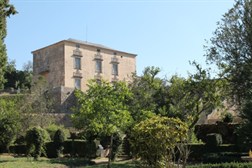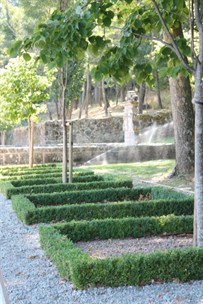The Spanish nobility and gardens: in the likeness of Italian villas
 A “theory” never developed in Spain about gardens, that explain their features, proper arrangement of their terraces, stairways, and fountains and ponds, the division of space for recreation, water use, the cultivation of trees and plants, etc. Theories of this type, however, were made in Italy, in treatises on architecture such as the famous one by Leon Battista AlbertiA Genoese humanist of the fifteenth century (1404-1472), mastered different disciplines, but especially distinguished himself in architecture. His treatises revolutionized modern architecture and were converted into authentic manuals for the artists of the Renaissance. Alberti worked for important patrons, such as the Popes of Rome, the Dukes of Ferrara and the Dukes of Mantua.. So it was not a coincidence that most of the gardens in the Spain of the Early Modern period imitated the culture of the Italian nobility which followed Classical tradition, while at the same time presenting characteristics of Iberian culture, such as the strong influence of MudéjarMudéjar art became widespread in the Iberian peninsula after the end of Muslim rule in al-Andalus. It consisted in the incorporation of elements of Arabian-inspired style in the new Christian. The most famous example of Mudéjar art is the Alcázar of Seville. art. In the Spanish context, the influence of the territories of Flanders was also very important, which produced a different way of designing and creating gardens. The interest in this particular type of artistic construction grew significantly since the reign of Philip II, whose Sitios RealesAre the places, especially palaces, that have served as the residence of the Spanish monarchs. Because of their historical and cultural importance El Escorial, the Palace of Aranjuez and the Royal Palace of Madrid stand out in particular. Inside they have preserved an important artistic heritage which consists in the original furniture that belonged to the royal family and of collections of paintings and tapestries of great value. Noteworthy are also gardens, fountains and lakes that surround these palaces. – places of leisure and rest with palaces, gardens and spectacular water effects – were a model for many important aristocratic families in Spain. This is the context for the interest in the residence known as El Bosque of the Dukes of Béjar, which still can be seen in its original appearance which dates back to the sixteenth and seventeenth centuries (pictures 1 and 2).
A “theory” never developed in Spain about gardens, that explain their features, proper arrangement of their terraces, stairways, and fountains and ponds, the division of space for recreation, water use, the cultivation of trees and plants, etc. Theories of this type, however, were made in Italy, in treatises on architecture such as the famous one by Leon Battista AlbertiA Genoese humanist of the fifteenth century (1404-1472), mastered different disciplines, but especially distinguished himself in architecture. His treatises revolutionized modern architecture and were converted into authentic manuals for the artists of the Renaissance. Alberti worked for important patrons, such as the Popes of Rome, the Dukes of Ferrara and the Dukes of Mantua.. So it was not a coincidence that most of the gardens in the Spain of the Early Modern period imitated the culture of the Italian nobility which followed Classical tradition, while at the same time presenting characteristics of Iberian culture, such as the strong influence of MudéjarMudéjar art became widespread in the Iberian peninsula after the end of Muslim rule in al-Andalus. It consisted in the incorporation of elements of Arabian-inspired style in the new Christian. The most famous example of Mudéjar art is the Alcázar of Seville. art. In the Spanish context, the influence of the territories of Flanders was also very important, which produced a different way of designing and creating gardens. The interest in this particular type of artistic construction grew significantly since the reign of Philip II, whose Sitios RealesAre the places, especially palaces, that have served as the residence of the Spanish monarchs. Because of their historical and cultural importance El Escorial, the Palace of Aranjuez and the Royal Palace of Madrid stand out in particular. Inside they have preserved an important artistic heritage which consists in the original furniture that belonged to the royal family and of collections of paintings and tapestries of great value. Noteworthy are also gardens, fountains and lakes that surround these palaces. – places of leisure and rest with palaces, gardens and spectacular water effects – were a model for many important aristocratic families in Spain. This is the context for the interest in the residence known as El Bosque of the Dukes of Béjar, which still can be seen in its original appearance which dates back to the sixteenth and seventeenth centuries (pictures 1 and 2).
 Of course, gardens appeared to be linked, across the European continent in the Early Modern period, to courtly and aristocratic environments, thought of as a special haven, as a place reserved only for a chosen few, devoted to retreat and rest, but also for leisure and entertainment. In 1651, Pedro Soto de RojasA writer from Granada (1584-1658) who distinguished himself as a poet in the court of Philip IV. Together with Luis de Góngora and Lope de Vega, the poetry of Soto de Rojas became famous during the period that the author spent in the courtly environment of Madrid. The last years of his life were spent in Granada, where he set most of his verse compositions. published his work Paraíso cerrado para muchos, jardines abiertos para pocos, which perfectly explained the elitist, eminently aristocratic conception, which existed regarding the garden in the Baroque period. A place for private leisure but rich of literary content (on Summer days story writers and poets in vogue at the moment were invited), theatre (not only plays and dances, but also naumachiaDramatization of naval battles in lakes and pools, which dates back to Roman times. was held in the lakes) and music (the sound of water, birds and silence). At the same time, during the Renaissance and Baroque the garden was also converted into the scenario in which the power and wealth of the owner-patron were represented, through festivals and refined activities that took place in it.
Of course, gardens appeared to be linked, across the European continent in the Early Modern period, to courtly and aristocratic environments, thought of as a special haven, as a place reserved only for a chosen few, devoted to retreat and rest, but also for leisure and entertainment. In 1651, Pedro Soto de RojasA writer from Granada (1584-1658) who distinguished himself as a poet in the court of Philip IV. Together with Luis de Góngora and Lope de Vega, the poetry of Soto de Rojas became famous during the period that the author spent in the courtly environment of Madrid. The last years of his life were spent in Granada, where he set most of his verse compositions. published his work Paraíso cerrado para muchos, jardines abiertos para pocos, which perfectly explained the elitist, eminently aristocratic conception, which existed regarding the garden in the Baroque period. A place for private leisure but rich of literary content (on Summer days story writers and poets in vogue at the moment were invited), theatre (not only plays and dances, but also naumachiaDramatization of naval battles in lakes and pools, which dates back to Roman times. was held in the lakes) and music (the sound of water, birds and silence). At the same time, during the Renaissance and Baroque the garden was also converted into the scenario in which the power and wealth of the owner-patron were represented, through festivals and refined activities that took place in it.
